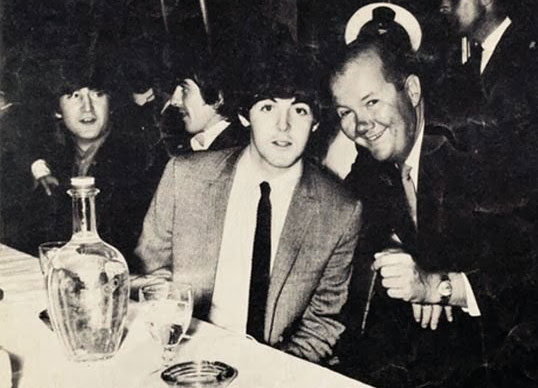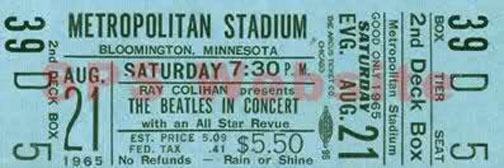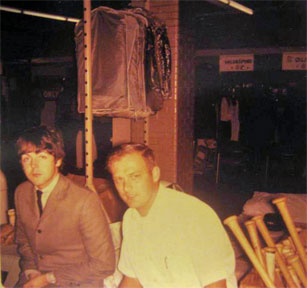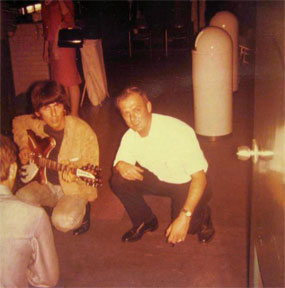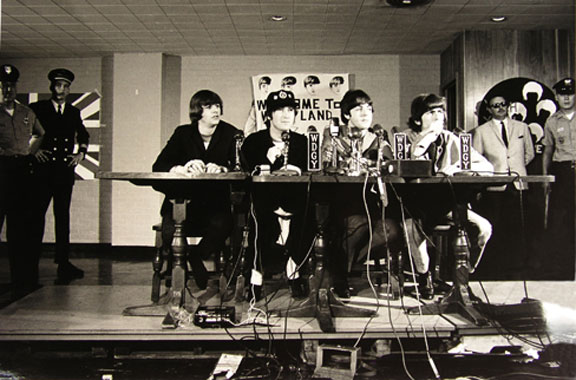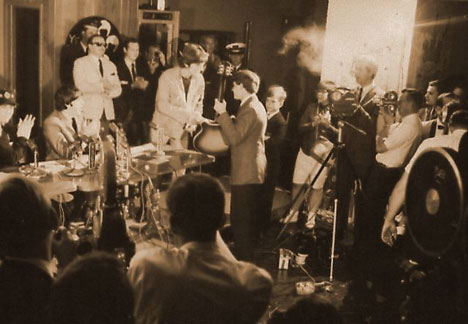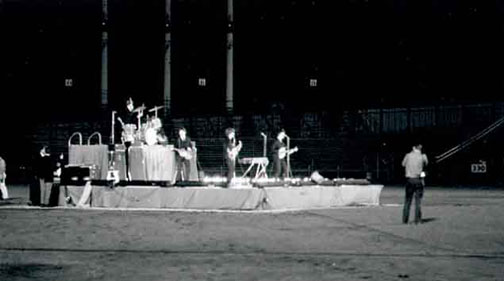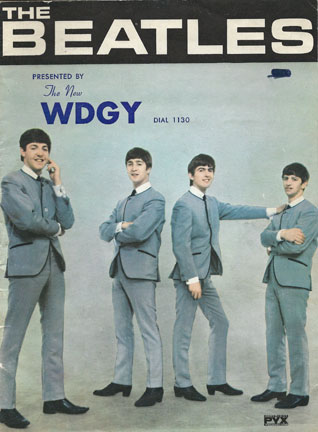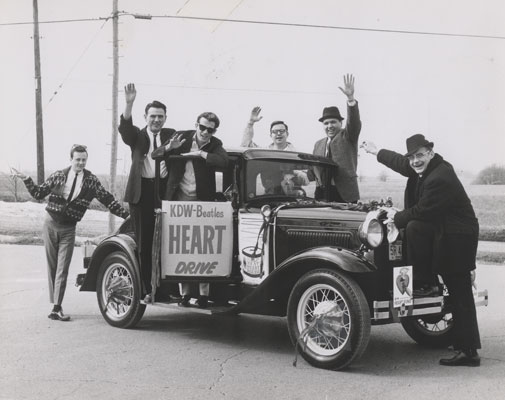 |
|
***Now until September 7, 2014, there is a Beatles exhibit at the Midwest Music Museum on the 4th Floor of the Mall of America. This is a traveling exhibit owned by the Grammy organization in Los Angeles, and has lots of fun artifacts. Also included are photos of the 1965 Minneapolis concert taken by Beatles tour manager Bob Bonis, and these are also for sale. Tickets are $7, and if you use the password "lovemedo" at the box office, you'll get a $2 discount. The website is www.midwestmusicmuseum.com ***
The Beatles came to town on August 21, 1965, and had a terrible time.
"Big Reggie" (aka Ray Colihan) from Danceland met them in Chicago in 1964 on their first tour; the photo below is dated September 5, 1964, according to the Internet source.
Reggie hired them for their second US tour in 1965, one of 11 concerts. He asked Bill Diehl of WDGY to be the M.C. Diehl went to Chicago to see them in action and to spend a day and a half with them. He brought back 16 mm film he took of the concert at the Stock Yards Amphitheater.
Although Beatlemania was into its second year, it was still very real. Their movie "Help!" was showing at the Orpheum Theaters in Minneapolis and St. Paul, and the album of the same name had just been released. Hoffbeck (see sources below) says that the concert was heavily advertised on rival rock 'n' roll radio stations KDWB and WDGY, one minute each hour for several months. Bill Diehl remembers that Colihan only publicized it by word of mouth and some print, but not on the radio, for fear of pandemonium (which they got anyway). Tickets were $2.50, $3.50, $4.50 and $5.50. The group received a guarantee of $50,000 and an additional 65 percent of sales above 18,500 tickets. 30,000 tickets were sold, earning Colihan a profit even though the 40,000-seat stadium was not sold out, the only non-sellout on the tour. (Was the fee delivered in cash at the last minute in a Red Owl grocery bag?)
ARRIVAL
THE LOCKER ROOM
Photos of Ringo, John, Paul, and George with and Ray Crump posted on Old Minneapolis Facebook page by Jill Griffith; taken by her father, who worked in concessions.
PRESS CONFERENCE
Before the concert, the Fab Four held a press conference in the Minnesota
Room of the stadium. Facing them were 12 microphones, 5 TV cameras, 150
reporters, and a few teenage "observers" who had won a contest. Most of the questions
were silly but then so were most of the answers. Somehow they kept coming
back to their hair.
Fred Anderson reveals how a picture of the Beatles at the press conference with
the second issue of Twin City a' GoGo ended up on the cover of the third
issue: a' Go Go editor Bruce Goldstein made arrangements with Big Reggie
to put copies of Issue #2 on the tables. The cover of #2 had pictures of the
individual Beatles, and the mop-tops (except Ringo) looked at the magazines and played with
them and such. The photo on the cover of issue #3 of the magazine was of
the Beatles with Issue #2. The picture was taken by Kent Kobersteen of the
Minneapolis Tribune. Fred (who worked as a copy boy there) made a print
of the negative and slipped it to Bruce.
RICKENBACKER PRESENTATION
At the press conference, Randy Resnick, local musician and B-Sharp Music employee, presented a Rickenbacker 360-12 electric 12-string guitar in a Fireglo red sunburst finish to George Harrison on behalf of the musicians of Minnesota. Resnick, pictured below, made the presentation, as captured by photographer Bill Carlson. Ron Butwin, another employee of B-Sharp, was also there for the presentation. They give slightly different accounts of how the presentation came to be.
Ron writes:
An edited version of the press conference is on YouTube (although it occasionally gets taken down); it was clearly Randy who presented the guitar and shook the hands of all four Beatles, although Ron is apparently right there as well.
George was genuinely touched and used the guitar during the show, but it disappeared a year later after their last concert in Candlestick Park in San Francisco. [Another account says the guitar was not used on the US tour, but Harrison played it on "If I Needed Someone" on 1965's "Rubber Soul."]
In a letter dated 7 September, 1965, George expressed his appreciation in a letter to Butwin:
THE SHOW
Local groups the Accents, Underbeats, TC Atlantic, and Gregory Dee and the Avanties played in the concourses (the Underbeats were embarrassed by that more than anything, according to an interview.)
The Beatles ran out of the dugout to the elevated stage at the pitcher's mound. Enduring terrible acoustics, the lads sang 11 songs in 35 minutes. "Twist and Shout" was reportedly deleted because John had throat problems.
There is a plaque at the Mall of America at the
spot where they played, about 40 yards from the closest fan.
Security guards and ushers were armed with smelling salts
for fainting fans. The number of police has been estimated
as up to 350 and came from Bloomington and Hennepin and
Ramsey Counties. Reports conflict as to whether the
concert had to be cut short when fans rushed the field.
Hoffbeck says that one fan broke free and went running but
was intercepted by police and hurled back over the fence.
Photo Minnesota Historical Society
A typical Beatles exit was made with a decoy limo and a real escape in a Falconers’ laundry van (they sat on folding chairs).
RADIO STATION HI-JINKS
Rock stations WDGY and KDWB were in mortal competition during these years, and did everything in their power to associate themselves with the Beatles. Stories told by Bill Diehl, head DJ at WDGY and Sam Sherwood, General Manager of KDWB vary, as can be expected.
Sherwood says that he met the Beatles in New York back in 1964 when they were in town to appear on the Ed Sullivan Show. He hung out with them at the Plaza Hotel and secured a phone line to the room. He called Lou Riegert back at the station in Minneapolis and Lou interviewed the boys on the air. Sam also somehow (he's not telling) surreptitiously obtained an acetate of each new Beatles song from a secret source in New York, hid it in his desk, and when he got the go-ahead, he transferred it to disk and put it on the air. Over the record the DJ would announce "This is a KDWB exclusive" so nobody could tape it and use it on another station. Sam says he was successful with this on all the records except for the German version of "I Wanna Hold Your Hand."
In 1965, when Big Reggie made the deal for the Beatles to come to Minneapolis, Sam says that he went to Chicago and met with the "real promoter." He was told that WDGY had a lock on it, sponsoring the press conference and emceeing the show. That decision was confirmed by Capitol Records branch manager Paul Goetz. Sherwood implored Goetz to let him participate in introducing the band. Goetz asked Diehl if Sherwood could be a part of the introduction, and Diehl said no. Sherwood told Goetz that if he couldn't be on the stage for the introduction, KDWB would never play any Beatles songs again. Diehl says that the rep asked him if Sherwood could be on the stage as well to introduce the Fab Four, but Diehl told him that the Beatles insisted that the emcee be a member of the American Guild of Variety Artists (the performer's union), which Sam was not. It went back and forth, and finally Diehl relented and allowed Sam to be on the stage for a brief moment.
Sam says that KDWB got the limo concession, with mobile phones so the boys could talk to the DJs while in transit to Met Stadium.
Sherwood says that KDWB was supposed to get the press conference, but because Bill Diehl of WDGY knew George Harrison's sister, Louise Harrison Caldwell, he got exclusive coverage, with the conference broadcast on WDGY, WDGY flags on all the microphones, and a "Welcome to WDGY Land" banner behind the table. Diehl says that Caldwell had nothing to do with that, and that WDGY had the press conference rights because of the agreement with Colihan. Diehl says that the only role Caldwell had is that she came to town and when Bill went to emcee dances, he would offer her services for a fee to the owner of the venue. Sometimes they would decline, but most times they would pay to have her there. The kids loved to talk to her and get her autograph, Bill remembered. The Diehls put her up at the Thunderbird Motel and they all went swimming. She left for home after a week.
Sherwood retaliated by telling his reporters to take all the front spots and prefacing their questions with "KDWB wants to know..." When one question didn't start out that way, Lennon asked, "Wait a minute, doesn't KDWB want to know?" Diehl says that someone from KDWB grabbed the line at a nearby phone booth in order to broadcast the press conference, but WDGY put two guys nearby to intone "WDGY is Number 1" and that was that.
Bill Diehl got the honor of introducing the stars of the show, prefaced with a warning that the show would be stopped if the fans rushed the stage (met with major boos). Beatles management had a lot of rules, including one that the emcee was not to tell corny jokes before the introductions. Bill faked them out with his introduction: "A funny thing happened to me on the way to the show.... THE BEATLES!!"
But Sherwood had another trick up his sleeve. To create a "headline event," he hired a helicopter with a banner that said "KDWB Welcomes the Beatles." The concert started, and he waited and waited and the thing didn't come, and it was getting dark, and finally there it was, buzzing the stadium. John Lennon used his guitar to shoot at the helicopter, and Sherwood got a huge kick out of the stunt. Nobody has turned up any photos of the helicopter so far.
THE LEAMINGTON MOTOR LODGE
Their not-so-luxurious accommodations were the entire 5th floor of the Leamington Motor Lodge (not the hotel) at 4th Ave. and 10th Street in downtown Minneapolis. Decoys were set up at much better digs but word got out and the place was mobbed with girls trying to get in. Bill Diehl remembers "grown women" climbing up downspouts on the outside of the building trying to get in, with cops pulling them down.
Police Inspector Donald R. Dwyer did not mince words expressing his distain for the mop tops, calling them a "typical traveling troupe," akin to circus performers. He claimed he'd found a girl in Paul’s room and charged him with making a “false hotel reservation.” Fortunately, the girl was able to prove that she was 21 (and from Cleveland). Dwyer told the Minneapolis Star that “Those people are the worst I have ever seen visit this city,” and in a press conference said "if they did not come [back] it would be too soon for me."
But Diehl says that he was up there with the Beatles, and that there was no way that, with all the money invested in them, that Brian Epstein would allow them to be involved with the scandal of having girls in their rooms, and that the police lied about what went on. Diehl said that the whole thing was blown completely out of proportion, and when the Beatles said they'd never come back to Minneapolis, Bill said he didn't blame them. (McCartney did return, though, on June 4, 1976, with his band Wings. The show at the St. Paul Civic Center did sell out.)
The Leamington Motor Lodge, saturated with the stale cigarette
smoke of thousands of traveling salesmen, was mercifully
demolished in February 2008.
ESCAPE FROM MINNESOTA
AFTERMATH
After the concert, Big Reggie was heard to say "Their manager just told me this was the best behaved bunch of kids they had played to yet.."
Correspondent Richard reports that "the next day my friends showed me certificates they had gotten that stated that they had seen the Beatles live at Met Stadium. The format of the certificate was loosely based on the format of a graduation certificate."
After seeing the girls screaming, hundreds of Minnesota boys headed to the music stores to buy guitars, and scores of Minnesota rock bands were formed.
Beatle fashions were also in vogue, with turtlenecks (available at Dayton's), Beatle Boots, and of course, Beatle haircuts. Wigs were actually popular, since some boys couldn't wear their long hair at their jobs or at school.
Met Stadium was demolished in 1985, and the Mall of America sits on the site today.
B-Sharp Music burned to the ground in May 2005, destroying autographed photos of the Beatles.
A film featuring
footage
shot by fans during the Beatles' tours in the '60s is in
the works.
Lou Riegert, James Frances Patrick O'Neill, Don Bowman, Charlie Brown, Sam Sherwood, & Car Owner Photo courtesy Sam Sherwood
The above information comes from a number of sources, including:
Back to Twin Cities Music Highlights
|
